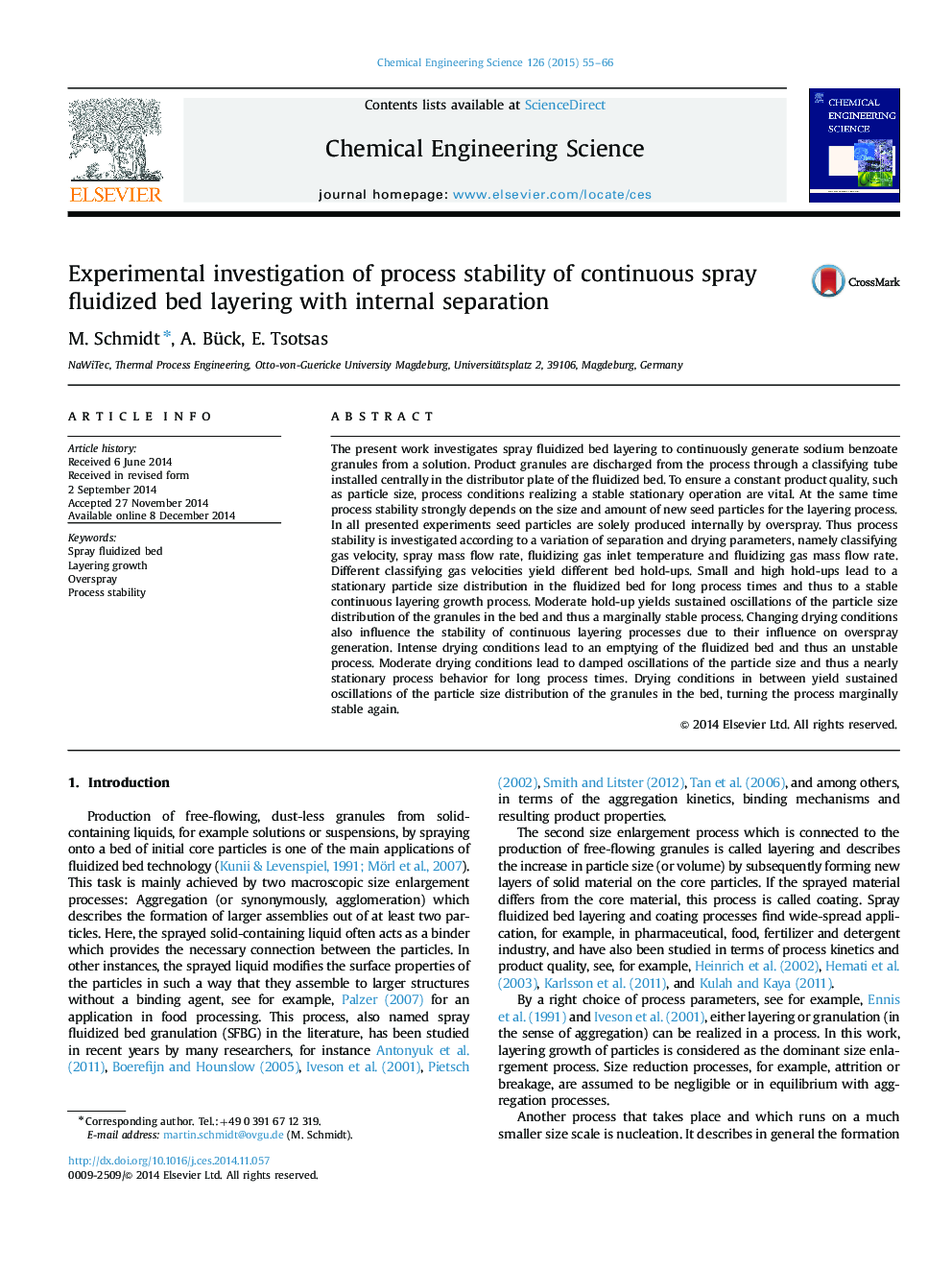| کد مقاله | کد نشریه | سال انتشار | مقاله انگلیسی | نسخه تمام متن |
|---|---|---|---|---|
| 6590217 | 456855 | 2015 | 12 صفحه PDF | دانلود رایگان |
عنوان انگلیسی مقاله ISI
Experimental investigation of process stability of continuous spray fluidized bed layering with internal separation
ترجمه فارسی عنوان
بررسی تجربی از ثبات فرایند لایه زدایی مایع اسپری مایع با جداسازی داخلی
دانلود مقاله + سفارش ترجمه
دانلود مقاله ISI انگلیسی
رایگان برای ایرانیان
کلمات کلیدی
اسپری کف مایع رشد لایه ای، پرش ثبات فرآیند،
ترجمه چکیده
در این مقاله، لایه بندی کف لایه های مایع اسپری به طور پیوسته گرانول های بنزوات سدیم از یک محلول تولید می شود. گرانول های محصول از طریق فرایند از طریق یک لوله طبقه بندی مرکزی در صفحه توزیع کننده بستر سیال قرار داده می شوند. برای اطمینان از کیفیت محصول ثابت، مانند اندازه ذرات، شرایط فرایند که عملیات پایدار ثابت را تحقق می بخشد، حیاتی است. در عین حال ثبات فرآیند به شدت به اندازه و مقدار ذرات بذر جدید برای روند لایه بندی بستگی دارد. در تمام آزمایش های ارائه شده، ذرات بذر صرفا از طریق اسپری تولید می شوند. بنابراین پایداری فرآیند با توجه به تغییر پارامترهای جداسازی و خشک شدن، یعنی طبقه بندی سرعت گاز، سرعت جریان اسپری، دمای ورودی گاز مایع شدن گاز و سرعت جریان جرمی سیال گاز بررسی می شود. سرعت های طبقه بندی گازی های مختلف دارای ضعف های مختلف تخت هستند. نگهداری های کوچک و بزرگ منجر به توزیع اندازه ذرات ثابت در بستر سیال شده برای فرایندهای طولانی و به همین ترتیب به یک فرایند رشد پایدار مستمر لایه بندی شده است. بازدارندگی مداوم باعث نوسانات پایدار توزیع اندازه ذرات گرانول در بستر می شود و در نتیجه یک فرایند با ثبات است. تغییر شرایط خشک شدن نیز بر پایداری فرایندهای لایه بندی پیوسته تاثیر می گذارد زیرا تاثیر آنها بر تولید نسل پر شدن است. شرایط خشک شدن شدید منجر به تخلیه بستر سیال شده و در نتیجه یک روند ناپایدار است. شرایط خشک شدن متوسط منجر به نوسانهای کم حجم ذرات و درنتیجه رفتار فرایندی تقریبا ثابت برای بارهای طولانی مدت می شود. شرایط خشک شدن در بین نوسانات بازدهی توزیع اندازه ذرات گرانول در بستر، چرخش فرآیند دوباره به طور ثانویه پایدار است.
موضوعات مرتبط
مهندسی و علوم پایه
مهندسی شیمی
مهندسی شیمی (عمومی)
چکیده انگلیسی
The present work investigates spray fluidized bed layering to continuously generate sodium benzoate granules from a solution. Product granules are discharged from the process through a classifying tube installed centrally in the distributor plate of the fluidized bed. To ensure a constant product quality, such as particle size, process conditions realizing a stable stationary operation are vital. At the same time process stability strongly depends on the size and amount of new seed particles for the layering process. In all presented experiments seed particles are solely produced internally by overspray. Thus process stability is investigated according to a variation of separation and drying parameters, namely classifying gas velocity, spray mass flow rate, fluidizing gas inlet temperature and fluidizing gas mass flow rate. Different classifying gas velocities yield different bed hold-ups. Small and high hold-ups lead to a stationary particle size distribution in the fluidized bed for long process times and thus to a stable continuous layering growth process. Moderate hold-up yields sustained oscillations of the particle size distribution of the granules in the bed and thus a marginally stable process. Changing drying conditions also influence the stability of continuous layering processes due to their influence on overspray generation. Intense drying conditions lead to an emptying of the fluidized bed and thus an unstable process. Moderate drying conditions lead to damped oscillations of the particle size and thus a nearly stationary process behavior for long process times. Drying conditions in between yield sustained oscillations of the particle size distribution of the granules in the bed, turning the process marginally stable again.
ناشر
Database: Elsevier - ScienceDirect (ساینس دایرکت)
Journal: Chemical Engineering Science - Volume 126, 14 April 2015, Pages 55-66
Journal: Chemical Engineering Science - Volume 126, 14 April 2015, Pages 55-66
نویسندگان
M. Schmidt, A. Bück, E. Tsotsas,
